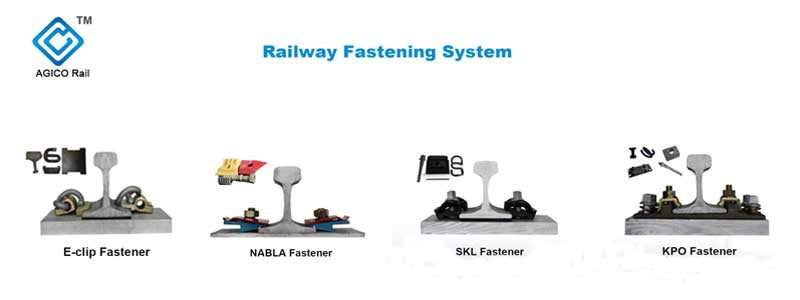
Rail fastening system is composed of rail fastenings. Rail fastenings are used to connect rail and railway sleeper. The main function of rail fastening system is fixing rail on the railway sleeper.
The common rail fastenings include rail spikes with base plates above the tie, E-clip fastening, Pandrol Fast Clip fastening, tension clamp fastening, bolt clamp fastening, tack joint and chairs fastening, and steel spring keyed rail in chair fastening.
For passenger railway line, comfort and reliability is major goal. Ballastless track laying not only refers to substructure, including bridge, tunnel and subgrade. The key techniques for rail fastening system are the necessary condition for railway operation.
With high shock absorption performance
The passenger railway generally adopt ballastless track requires better elasticity of rail fastening system compared to ballast track. Elasticity of rail fastening system can’t be increased without limit. Otherwise it will have influence on smoothness of rail. So Balance rigidity of rail fastening and rail safety is one of the key techniques for rail fastening system.
With good insulation property
According to requirement of track circuit, rail fastening system must have good insulation property in the dry-wet-cycle condition. So that key techniques for rail fastening system is required to improve water resistor.
Versatility of rail fastening system in continuous welded rail track
As requirement of laying continuous welded rail track, rail fastening system in tunnel and ballast should have enough anti-creeping resistance. In general, the bigger anti-creeping resistance, the better welded rail track will be. So it usually use rail clip with bigger crimping force to fasten rail.
For laying continuous welded rail track on the bridge, it always adopts rail fastenings with less anti-creeping resistance. In another word, using rail clip with less crimping force to fasten rail. Besides, rail clip should be used with low friction coefficient rail pad.
In sum, the key technique for rail fastening system requires the versatility of rail fastening system. Rail fastening system should installing rail clip with bigger crimping force and installing rail clip with less crimping force.
Versatility of rail fastening system in ballastless track structure
Ballastless track structures vary, but from the view of design, construction and operation management, it requires rail fastening system has versatility. Both sleepers buried ballastless track and slab ballastless track can use one rail fastening system together. Key techniques for rail fastening system include fitting various ballastless track structures.
Crimping force loss and fatigue life
The rigidity of rail pad decrease, which means rail pad have large deformation during train passing. At the same time, front of rail clip have bigger dynamic deformation. It has higher need on elastic property and fatigue property of rail clip. When low-rigidity rail pad applied, the key technique is control crimping force loss and fatigue life of rail clip.
The reliable connection between rail fastening system and concrete foundation
Ballastless track usually adopt elastic separated rail fastening (with a tie plate). According to functional need, tie plate is fastened on the concrete foundation through anchor bolt and rail plastic dowel cooperation (which is pre-embedded into the concrete). Based on experience, strength and fatigue life of embedded parts in construction is a weak link. Improve the strength and fatigue life is one of the key techniques need to be solved.
Less spare parts and easy operation mode
Summarising experience on ballastless track, adjustment amount of rail location is large and accurate. In conclusion, good rail fastening system has less spare parts and adopt easy operation mode to adjust rail position. When the left and right side is adjusted, try to avoid changing fastening. Step-less adjusting will be the best adjusting mode.
